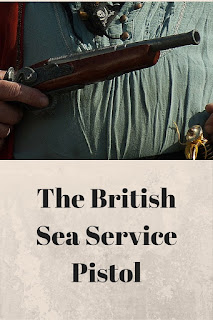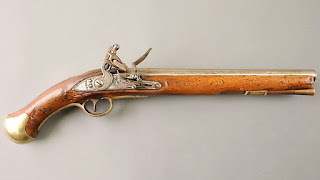The British Sea
Service Pistol
The Royal Navy issued flintlock pistol known as the British Sea
Service pistol was one of the most common firearms in the 18th and
early 19th century. The Board of Ordinance oversaw the manufacture
and distribution of these pistols which were issued from the early 1700s until
1815. The pistols were assembled in the Tower armory but the pieces came from
various sources. Made of brass, steel and wood, the user loaded it by ramming
the ball and black powder down the nine or twelve inch barrel. The length of
the barrel depended on the year it was made, with earlier versions being longer
and later versions being shorter. It was a solid weapon meant for use in close
fighting during boarding. The pistol had a special hook on it for securing it
to a sailor’s clothing, and this hook was missing from the Army version of this
weapon.
The user of the pistol only got one
shot. Afterwards, it was pretty good for whacking the enemy but not much else,
unless a seaman could find a place to hunker down and reload, which, in the
heat of battle, wasn’t likely. Also, since hitting someone with the pistol
could damage it, there is some debate as to whether or not empty pistols were
used for this purpose.
The fact that the pistols were government issue did not mean
that they were accurate or safe. They weren’t. Flintlocks had a bad habit of
misfiring and the harsh sea air aboard ship could wreck havoc on their springs
and hammers. The phrase “a flash in the pan” came about in reference to misfires.
A flash in the pan is when the flint ignites the gunpowder, or charge as it was
known, in the pan but does not fire the ball. With the enemy bearing down on
you, this would not be a good thing.
Officers usually had their own weapons especially made for
them, but many weren’t above using the standard issue Sea Service pistol. In
the painting Nelson Boarding the ‘San
Josef’ at the Battle of Cape St. Vincent by George Jones you can see Admiral Nelson holding a Sea Service pistol. Thousands of the
pistols remained in circulation for decades after they were no longer issued and
it wasn’t just the British who used them. The weapon ended up in several
countries, including America, as various enemies captured British supply ships
during the numerous wars. Even the East India Company preferred the
pistols.
 The heyday of the Sea Service pistol would come to an end in
the mid 18th century when flintlocks were replaced by percussion cap
pistols, However, the Sea Service still remained as many were changed into the
less hazardous, but no more accurate percussion cap design. An example is the pistol at right. Although not a Sea Service pistol you can see the percussion cap. Despite the changes, the Sea Service pistol remained a
workhorse and a staple of life aboard ship. One of these pistols also plays an
integral part in the plot of A Debt Paid in Marriage, the first book in my Business of Marriage series from
Harlequin Historical.
The heyday of the Sea Service pistol would come to an end in
the mid 18th century when flintlocks were replaced by percussion cap
pistols, However, the Sea Service still remained as many were changed into the
less hazardous, but no more accurate percussion cap design. An example is the pistol at right. Although not a Sea Service pistol you can see the percussion cap. Despite the changes, the Sea Service pistol remained a
workhorse and a staple of life aboard ship. One of these pistols also plays an
integral part in the plot of A Debt Paid in Marriage, the first book in my Business of Marriage series from
Harlequin Historical.
For a more detailed article about the pistol check out https://www.americanrifleman.org/articles/2016/1/27/i-have-this-old-gun-british-pattern-1801-sea-service-pistol/
If you liked this post you must like history. There's a lot of history in my books so you'll love them www.georgie-lee.com
If you liked this post you must like history. There's a lot of history in my books so you'll love them www.georgie-lee.com




1 comment:
Every time I read a really great article I go ahead and do some things:1.Show it to the close friends.2.Bookmark it in all my popular sharing sites.3.Make sure to come back to the same website where I came accross the post.After reading this post I am really thinking of doing all three. essay writing service uk
Post a Comment